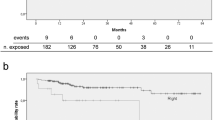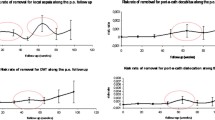Abstract
The first placement of a totally implantable central venous access device (TIVAD) was performed in 1982 at the MD Anderson Cancer Center in Houston by John Niederhuber, using the cephalic vein—exposed by surgical cut-down—as route of access to central veins. After that, TIVADs proved to be safe and effective for repeated administration of drugs, blood, nutrients, and blood drawing for testing in many clinical settings, especially in the oncologic applications. They allow for administration of hyperosmolar solutions, extreme pH drugs, and vescicant chemotherapeutic agents, thus improving venous access reliability and overall patients’ quality of life. Despite the availability of a variety of devices, each showing different features and performances, many issues are still unsolved. The aim of this review article is to point out what has changed since the first implant of a TIVAD, and what it is still matter of debate, thus needing more investigation. Topics analyzed here include materials, choice of the veins and techniques of implantation, role of ultrasound (US) guidance in central venous access, position of catheter tip assessment, TIVAD-related infection and thrombosis, and quality of life issues.
Similar content being viewed by others
References
Niederhuber JE, Ensminger W, Gyves JW et al (1982) Totally implanted venous and arterial access system to replace external catheters in cancer treatment. Surgery 92:706–712
Pratt RJ, Pellowe CM, Wilson JA et al (2007) epic2: national evidence-based guidelines for preventing healthcare-associated infections in NHS hospitals in England. J Hosp Infect 65(suppl):S1–S64
Biffi R, De Braud F, Orsi F et al (2001) A randomized, prospective trial of central venous ports connected to standard open-ended or Groshong catheters in adult oncology patients. Cancer 92(5):1204–1212
Maki DG, Kluger DM, Cornich CJ (2006) The risk of bloodstream infection in adults with different intravascular devices: a systematic review of 200 published prospective studies. Mayo Clin Proc 81:1159–1171
Hockenhull JC, Dwan K, Boland A et al (2008) The clinical effectiveness and cost effectiveness of central venous catheters treated with anti-infective agents in preventing bloodstream infections: a systematic review and economic evaluation. Health Technol Assess 12:1–154
O'Grady NP, Alexander M, Burns LA et al (2011) Guidelines for the prevention of intravascular catheter-related infections. Clin Infect Dis 52:162–193
Center for Devices and Radiological Health. Reminders from FDA regarding ruptured vascular access devices from power injection, July 7 - 2004. Available at: www.fda.gov/cdrh/medicaldevicesafety/tipsarticles/reminder-rvad.html
Bonciarelli G, Batacchi S, Biffi R et al (2011) GAVeCeLT consensus statement on the correct use of totally implantable venous access devices for diagnostic radiology procedures. J Vasc Access 12:292–305
Di Carlo I, Toro A (2011) Choice of venous sites. Surgical implant/technique. In: Di Carlo I, Biffi R (eds) Totally implantable venous access devices. Springer-Verlag, Italia, pp 43–54
Toro A, Mannino M, Cappello G et al (2012) Totally implanted venous access devices implanted in saphenous vein. Relation between the reservoir site and comfort/discomfort of the patients. Ann Vasc Surg 26(8):1127.e9–1127.e13
Coit DG, Turnbull AD (1988) A safe technique for the placement of implantable vascular access devices in patients with thrombocytopenia. Surg Gynecol Obstet 167:429–431
Knebel P, Fischer L, Huesing J et al (2009) Randomized clinical trial of a modified Seldinger technique for open central venous cannulation for implantable access devices. Br J Surg 96:159–165
Biffi R, Orsi F, Pozzi S et al (2009) Best choice of central venous insertion site for the prevention of catheter-related complications in adult patients who need cancer therapy: a randomized trial. Ann Oncol 20:935–940
Randolph AG, Cook DJ, Gonzales CA, Pribble CG (1996) Ultrasound guidance for placement of central venous catheters: a meta-analysis of the literature. Crit Care Med 24:2053–2058
Hind D, Calvert N, McWilliams R et al (2003) Ultrasonic locating devices for central venous cannulation: meta-analysis. BMJ 327:361–367
Calvert N, Hind D, McWilliams R et al (2004) Ultrasound for central venous cannulation: economic evaluation of cost-effectiveness. Anaesthesia 59:1116–1120
Karakitsos D, Labropoulos N, De Groot E et al (2006) Real-time ultrasound-guided catheterisation of the internal jugular vein: a prospective comparison with the landmark technique in critical care patients. Crit Care 10:R162
Lamperti M, Bodenham AR, Pittiruti M et al (2012) International evidence-based recommendations on ultrasound-guided vascular access. Intensive Care Med 38:1105–1117
Barsuk JH, McGaghie WC, Cohen ER (2009) Simulation-based mastery learning program reduces complications during central venous catheter insertion in a medical intensive care unit. Crit Care Med 37:2697–2701
Lefrant JY, Cuvillon P, Bénézet JF et al (1998) Pulsed Doppler ultrasonography guidance for catheterization of the subclavian vein: a randomized study. Anesthesiology 88:1195–1201
Bold RJ, Winchester DJ, Madary AR et al (1998) Prospective, randomized trial of Doppler-assisted subclavian vein catheterization. Arch Surg 133:1089–1093
Fragou M, Gravvanis A, Dimitriou V et al (2011) Real-time ultrasound-guided subclavian vein cannulation versus the landmark method in critical care patients: a prospective randomized study. Crit Care Med 39:1607–1612
Di Carlo I, Toro A (2012) Skin incision to implant the port: could be this the real reason to prefer the surgical cut down to implant a totally implantable venous access device? Ann Surg 255:e9
Nakazawa N (2010) Challenges in the accurate identification of the ideal catheter tip location. JAVA 15:196–200
Cadman A, Lawrence JA, Fitzsimmons L et al (2004) To clot or not to clot? That is the question in central venous catheters. Clin Radiol 59:349–355
Caers J, Fontaine C, Vinh-Hung V et al (2005) Catheter tip position as a risk factor for thrombosis associated with the use of subcutaneous infusion ports. Support Care Cancer 13:325–331
Korones DN, Buzzard CJ, Asselin BL, Harris JP (1996) Right atrial thrombi in children with cancer and indwelling catheters. J Pediatr 128:841–846
Food and Drug Administration Task Force (1989) Precautions necessary with central venous catheters. FDA Drug Bulletin, 15-16
National Association of Vascular Access Networks (1998) NAVAN position statement. J Vasc Access Devices 3:8–10
(2001) National Kidney Foundation K/DOQI clinical practice guidelines for vascular access. Am J Kidney Dis 37(Suppl 1):S137-S181
Pittiruti M, Hamilton H, Biffi R et al (2009) ESPEN guidelines on parenteral nutrition: central venous catheters (access, care, diagnosis and therapy of complications). Clin Nutr 28:365–377
Stas M, Willems R (2011) Verifying catheter tip position: fluoroscopy vs intravasal electrogram. In: Di Carlo I, Biffi R (eds) Totally implantable venous access devices. Springer-Verlag, Italia, pp 93–104
Fricke BL, Racadio JM, Duckworth T et al (2005) Placement of peripherally inserted central catheters without fluoroscopy in children: initial catheter tip position. Radiology 234:887–892
Neubauer AP (1995) Percutaneous central iv access in the neonate: experience with 535 silastic catheters. Acta Paediatr 84:756–760
Pawlik MT, Kutz N, Keyl C et al (2004) Central venous catheter placement: comparison of the intravascular guidewire and the fluid column electrocardiograms. Eur J Anaesthesiol 21:594–599
Stas M, Mulier S, Pattyn P et al (2001) Peroperative intravasal electrographic control of catheter tip position in access ports placed by venous cut-down technique. Eur J Surg Oncol 27:316–320
Richards MJ, Edwards JR, Culver DH et al (2000) Nosocomial infections in combined medical surgical intensive care units in the United States. Infect Control Hosp Epidemiol 21:510–515
Raad I, Hanna H, Maki D (2007) Intravascular catheter-related infections: advances in diagnosis, prevention, and management. Lancet Infect Dis 7:645–657
Provonost P, Needham D, Berenholtz S et al (2006) An intervention to decrease catheter-related bloodstream infections in the ICU. N Engl J Med 355:2725–2732
Kuter DJ (2004) Thrombotic complications of central venous catheters in cancer patients. Oncologist 9:207–216
Verso M, Agnelli G (2003) Venous thromboembolism associated with long-term use of central venous catheters in cancer patients. J Clin Oncol 21:3665–3675
Karthaus M, Kretzschmar A, Kröning H et al (2006) Dalteparin for prevention of catheter-related complications in cancer patients with central venous catheters: final results of a double-blind, placebo-controlled phase III trial. Ann Oncol 17:289–296
Chan A, Iannucci A, Dager WE (2007) Systemic anticoagulant prophylaxis for central catheter associated venous thrombosis in cancer patients. Ann Pharmacother 41:635–641
Agnelli G, Verso M (2006) Therapy insight: venous catheter-related thrombosis in cancer patients. Nat Clin Pract Oncol 3:214–222
Fagnani D, Franchi R, Porta C et al (2007) Thrombosis-related complications and mortality in cancer patients with central venous devices: an observational study on the effect of antithrombotic prophylaxis. Ann Oncol 18:551–555
van Rooden CJ, Schippers EF, Barge RM et al (2005) Infectious complications of central venous catheters increase the risk of catheter-related thrombosis in hematology patients: a prospective study. J Clin Oncol 23:2655–2660
Goossens GA, Vrebos M, Stas M et al (2005) Central vascular access devices in oncology and hematology considered from a different point of view: how do patients experience their vascular access ports? J Infus Nurs 28:61–67
Chenecky C (2001) Satisfaction versus dissatisfaction with venous access devices in outpatient oncology: a pilot study. Oncol Nurs Forum 28:1613–1616
Landen CN, Younger NO, Sharp BAC, Underwood PB (2003) Cancer patients’ satisfaction with physicians: Princess Margaret Hospital satisfaction with doctor questionnaire results. Am J Obstet Gynecol 188:1177–1179
Ayanian JZ, Zaslavsky AM, Guadagnoli E et al (2005) Patients’ perception of quality of care for colorectal cancer by race, ethnicity, and language. J Clin Oncol 23:6576–6586
Johansson E, Engervall P, Bjorvell H et al (2009) Patients’ perceptions of having a central venous catheter or a totally implantable subcutaneous port system—results from a randomized study in acute leukaemia. Support Care Cancer 17:137–143
Ignatov A, Hoffman O, Smith B et al (2009) An 11-year retrospective study of totally implantanted central venous access ports: complications and patient satisfaction. Eur J Surg Oncol 35:241–246
Marcy PY, Magné N, Castadot P et al (2005) Radiological and surgical placement of port devices: a 4-year institutional analysis of procedure performance, quality of life and cost in breast cancer patients. Breast Cancer Res Treat 92:61–67
Marcy PY, Magné N, Castadot P et al (2007) Is radiologic placement of an arm port mandatory in oncology patients? Analysis of a large Bi-institutional experience. Cancer 110:2331–2338
Biffi R, Orsi F, Pozzi S et al (2011) No impact of central venous insertion site on oncology patients' quality of life and psychological distress. A randomized three-arm trial. Support Care Cancer 19:1573–1580
Conflict of interest
We here declare we have full control of all primary data, and we agree to allow the Journal to review them if requested.
Author information
Authors and Affiliations
Corresponding author
Rights and permissions
About this article
Cite this article
Biffi, R., Toro, A., Pozzi, S. et al. Totally implantable vascular access devices 30 years after the first procedure. What has changed and what is still unsolved?. Support Care Cancer 22, 1705–1714 (2014). https://doi.org/10.1007/s00520-014-2208-1
Received:
Accepted:
Published:
Issue Date:
DOI: https://doi.org/10.1007/s00520-014-2208-1




